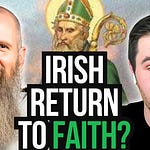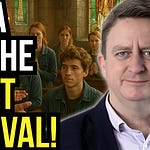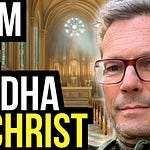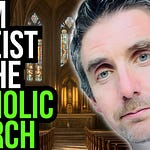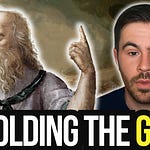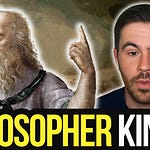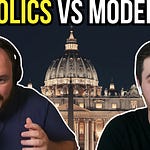Carl Gustav Jung was a Swiss psychologist, prominent at the turn of the last century and the creator of depth psychology. Jung is an early proponent of the hero meta-mythology, a discoverer of the collective unconscious and a psychologist who spent his life cataloguing the universal symbols of the mind through dreams and active imagination. Jung attempted to respond explicitly to the meaning crisis and the dissolution of the Western mind, which he witnessed first-hand in Germany during WW2. Jung also argued that the origins of current individual troubles started with the death of God and the loss of the Christian worldview, which had reigned for over a thousand years. However, Jung thought God would reappear again in the psyche because God had disappeared from the external world in secular society.
In this essay, we will be operationalising and situating the worldview we have been expounding throughout the series in a modern context through Jungian individuation, drawing some connections with Neoplatonic ideas, and finally, using a dramatic example, we will look at Jordan Peterson’s myth of Pinocchio and how this mythologises the process of self-development and can reveal for us lots we can learn about ourselves.
Jung’s Theory of the Psyche.
Freud was Jung’s mentor, and Freud had a hydraulic and essentially mechanistic theory of the psyche, being a materialist doctor initially. Freud was a towering figure who made one of the most tremendous psychological discoveries of the turn of the century was the unconscious mind and the recognition that much of what we do happens outside our conscious mind. As Freud wrote, “We are not masters in our own house”. However, over his materialism and sexual theory dogmatism, Jung split with Freud. For Jung, the psyche is a self-regulating system like the body, which is why Veraveke calls Jung ‘The Plato of the Psyche’. Jung looked at the psyche as a pantheon of living and warring psychic organs called archetypes that strove to maintain homeostasis and aimed at development through the process of individuation. This is why Jung said, “Until you make the unconscious conscious, it will direct your life and you will call it fate.”
For Jung, the sum total of the conscious and unconscious mind, which was also the sum total of our full potential, was the self. The self was what drove us towards their process of individuation, to psychological wholeness. The self has three levels: the ego - the centre of our consciousness, sense of identity, organising thoughts and feelings, and linking the inner and outer worlds. The unconscious had two levels in Jung’s theory; a personal unconscious that contained the total of our knowledge, which was not currently being accessed, everything outside of direct attention yet to be remembered and thus is the house of all potential future development. The third part of the self is the collective unconscious, populated by universal symbols, which are the stock characters of the human mind. These stock characters of the mind are called Archetypes, which comes from the original Greek ‘arche typos’ meaning ‘pattern’ or ‘the original pattern from which all copies are made’. (In a previous essay, we discussed Plato’s forms, structural functional organisations, and the forms and archetypes are essentially the same thing.)
To understand Archetypes are images of inborn patterns of behaviour, like how a bird builds a nest by instinct. The bird doesn’t have to go to the nest-building school. For Jung, this is the ‘biological mind’ populated by universal symbols, which we see reflected in myths and stories. He came to this understanding empirically by examining thousands of his patients’ dreams and cataloguing the overlap of universal symbols. He would have secular patients with religious, Egyptian, Greek, and Christian symbols in dreams and couldn’t figure out why? Some argue he was also influenced by James Joyce’s Finnegan’s Wake, which deals with the unconscious and the so-called ‘mono-myth’, which Joesph Campbell wrote “The Hero with a Thousand Faces” about; coincidently, the book Campbell wrote before “The Hero with a Thousand Faces” was the Skeleton key on Finnegan’s Wake. Jung argues this mono-myth is essentially the structure of the unconscious, and dreams were super crucial to understanding the unconscious because they gave us an unvarnished look at what was going on in the psyche:
“Dreams are impartial, spontaneous products of the unconscious psyche, outside the control of the will. They are pure nature; they show us the unvarnished, natural truth, and are therefore fitted, as nothing else is, to give us back an attitude that accords with our basic human nature when our consciousness has strayed too far from its foundations and run into an impasse.” [Collected Works Volume 10, paragraph 317]
Plato also looked at dreams as communication between Gods and human beings and as a way of gleaning important insights for guidance and wisdom. So essentially, Jung believed dreams could show us things we didn’t know yet but needed to know; important self-knowledge hidden from consciousness could be reintegrated by recording and analysing dreams. Self-knowledge for Jung was knowledge of the unconscious; therefore, dreams, active imagination and free association were essential ways of getting in touch with yourself outside of consciousness.
In the previous essay, number 3, we described the hero meta-mythology as a generalised narrative description of the individual process of successful creative adaptation, which was motivationally or affectively optimal. Jung thought that the problem for modern individuals was that we lacked a modern myth to live within. Myths are dramatic maps for knowing how to live well and how we act, but as modern people, we can no longer believe in them? Jung saw this inner conflict as causing all sorts of existential problems for the modern individual, exposing us to chaos and creating neuroses. Jung said: “Everybody acts out a myth, but very few people know what their myth is. And you should know what your myth is because it might be a tragedy and maybe you don’t want it to be.” The way the individual comes to know the myth they are in and to change the story, so to speak, is through the journey of individuation.
The Journey of Individuation.
Jung appropriated the natural philosophy of alchemy to plug this mythic void in the modern world. Alchemy, on the surface, appeared to be a proto-science attempt to transmute base metals (lead) into gold. The alchemists would do this by creating a philosopher’s stone, a stone or precious gem that could turn base metal into gold and allow the owner to live forever. Jung looked at alchemy not literally but as a profound metaphor for personal transformation and that the Philosopher’s Stone was essentially the philosophy that could bring about that transformation.
Pierre Grimes, a prominent Platonist in the late ’70s, argued that Jung was philosophically a Platonist. He makes this argument because Jung’s philosophy of self-formation or self-development (the process of individuation) is rooted in the Hermetic philosophy, also known as alchemy. Hermetic philosophy is attributed to the semi-mythological Hermes Trismegistus, falesly considered until the Renaissance to be a contemporary of Moses, but was discovered to have originated in the 2nd or 3rd century - the time of Middle Platonism. Why is this significant? Grimes connects Jung’s journey of individuation to the Platonic anagogic ascent (represented mythologically as the journey out of the cave), which we have also equated throughout this series with the hero meta-mythology. This convergence of two separate but inter-penetrating traditions (Platonism and neoplatonism, and the monomyth, alchemy and depth psychology), significantly increases the plausibility of the argument that we are touching on a universal and perennial path of self-development.
In alchemy, the prima materia was the base metal of lead, which Jung took to be the un-formed individual. The symbol of this un-formed individual was the Ouroboros: a dragon eating its own tail to form a never-ending circle, symbolising chaos or pure potentiality. Here we can again connect with the Neoplatonic journey to the one, which also puts pure potential (matter) at the bottom of the hierarchy of being and pure actuality at the top. This is no different from alchemy, with the top spot, the philosophical gold, being an analogy for psychological wholeness; the same aim as the ‘oneness’ of Neoplatonism or becoming ‘One’. In conclusion, I think it’s fair to look at the journey of alchemy, individuation and Neoplatonism as aiming at the same thing, the integration and coordination of disparate parts of the psyche into a unity. So, how does journey of individuation work?
The Shadow.
There is no straightforward method for Jung’s journey of individuation, but typically the ‘apprentice-piece’ is the confrontation with the shadow. The shadow represents the rejected aspects of the psyche and hence, as that which is not encountered, holds’s transformative potential. This involves integrating aspects of yourself that are often taboo or rejected in society, like sex and aggression, or maybe even these days, order and discipline.
For Jung, individuation is how one self-develops out of an undifferentiated unconsciousness by integrating the unconscious parts of the psyche into consciousness, separating pure potentiality and using inner experiences to build one’s consciousness. This was all based on Jung’s principle of enantiodromia, which he described as ‘the most marvellous psychological law’. He defined enantiodromia as the ‘emergence of the unconscious opposite in the course of time’. This roughly means that an opposite unconscious reaction eventually compensates if we live in an unconscious and one-sided manner - it’s a dialogical process between unconscious and conscious minds, like the Platonic anagoge. Plato also articulated this in Phaedo “everything arises in this way, opposites from their opposites.” (sect. 71a)
For example, a chronic nice guy who completely rejects anger and aggression will often become resentful and possibly sadistic and cruel as a result. Their rejection of anger, which is the archetypical God of war Ares, results in possession by this archetype. It’s paradoxical, to paraphrase Joyce: you run into what you run from! Another way of thinking about enatiodromia is that instincts have much more control over us when we are unconscious of them. Obviously, self-control, by definition, is something we are aware of; we have to be consciously aware of these drives to inhibit them, otherwise they can run rampant. So when the chronic nice guy rejects aggression, this inhibits his development because anger and aggression integrated becomes independence, assertiveness, tenacity, industry, etc. A lack of independence, assertiveness etc would not be fuel for positive emotion, but rather the opposite, chronic frustration and probably resentment.
A weakness of Jungian analysis is that it is often profoundly introverted and occurs within the individual mind only; however, action is also required to transform the psyche. One way for the nice guy to overcome this dilemma would be to practise being assertive and saying ‘no’ to people, and taking care of his own needs and not always everybody else’s. A chronic nice guy who breaks down from one-sidedness and then begins to integrate their shadow, aggression in this case into tenacity and leadership, is a more “individuated” person in Jungian terms; integrated, complexified, and hence "real-ised” (made real-er) by the incorporation of the opposing principle.
Another example of the confrontation with the shadow comes from Peterson on the myth of the knights of the Roundtable. When the knights set off for the holy grail, a symbol of psychological wholeness, each begins their search where the’ forest looks darkest to them’, in other words, where they are most afraid to go. The idea is that the place you least want to go holds the most potential development because it is where you have not been. As it is said in Alchemy, “In sterquilinus Invenitur’ - “In filth it will be found”. This is a fundamental reorientation in life, from your comfort zone to the difficult but rewarding ‘zone of proximal development’ in Vygotski’s language or to the edge of your competence. You could argue this is the start of each of our personal hero’s journeys, entering the forest wherever is darkest to us. Unfortunately, unlike the Knights of the Roundtable, we must make this choice every day, even when we feel like shirking off and running away.
Phenomenologically the shadow can be resistant to this confrontation. In the ‘War of Art’, Stephen Pressfield describes the obstacle to one’s development as ‘resistance’, a voice in your mind that tries to discourage you from taking the challenges that will help you grow. David Goggins calls this voice ”the governor”, like a car governor that controls the speed limit. The psychologist Stutz, in The Tools, describes this inner-obstacle voice as “Part X”. Whatever you want to call it - there is something in you that doesn’t want you to be your best, and it’s something you have to overcome to fulfil your potential. The is is why the confrontation with the shadow is difficult but necessary. The confrontation with the shadow is the proverbial leaving the Cave, the safety of the village, to enter the dark woods of the unknown, in the hopes of discovering the gold, a more integrated personality, self-real-isation. The confrontation with the shadow can be summed up as “face what you reject, accept what you refuse to acknowledge, and you will find the treasure the dragon guards”.
The Anima & Animus.
According to Jung the confrontation with the shadow and the ensuing consciousness enlargement brought one into contact with the contra-sexual element of the psyche. For women, this is a man (the Animus); for men, this is a woman (the Anima). This is a confrontation with the inner other, and similarly to the shadow example, if we do not pay homage to this inner other, then we will become ‘possessed’ by it. If the shadow is the ‘apprentice piece,’ then the Anima and Animus are the ‘masterpiece.’
For a man in Jung’s philosophy, the Anima demands success, his greatest, or she will torture him and drive him to illusion. Jung looked at the male Anima as progressing through four stages:
(1) First was Eve, indistinguishable from the personal mother.
(2) The second was a personification in Helen of Troy, the ideal sexual image.
(3) The third was Mary, which manifests in religious feelings and a capacity for lasting relationships.
(4) The fourth stage is Sophia, Wisdom.
A man’s Anima functions as a guide to the inner life, mediating to consciousness the contents of the unconscious - this is a functional relationship between the unconscious and consciousness. The stages of development for the female Animus are comparable (read more here) but ultimately culminate in Hermes, which is worth mentioning, to make this less abstract. Wisdom, or Sophia, is personified in Greek Philosophy by the Goddess Athena, who was often put together with Hermes in ancient sculptures to make a Hermathena. They both frequently assist crusading heroes and are the gods of good judgement, quick wit and cunning. The Hermathenastatue was featured in Cicero’s classroom, and he thought it an appropriate emblem of ‘learning’. Jung thought that what we don’t know is projected onto the unknown in the world. The Anima and Animus stage for Jung is about overcoming projection, essentially, illusion, being able to separate illusion and reality; true discernment. Really what the anima and animus is about are attention, salience and truth.
We discussed this in the first essay unconscious forces pull our attention in ways we can’t understand. Hermes is the winged messenger of the Gods; he mediates between the unconscious and the conscious mind. Interestingly, Herme’s mother mythologically was ‘Maya’, the Goddess of illusion. The Greeks knew this problem with attention, and their panoply of God’s was the sum total of unconscious forces that can act our attention. By sacrificing to God’s and negotiating with them, we gained the ability to direct our attention. The Gods try to orient you in a particular direction by making things more vivid and salient, attracting your attention; they illuminate and darken your path as they guide you. If you are possessed by the wrong unconscious forces, they may take you somewhere you don’t want to go. Integrating these unconscious forces into a functional unit manifests as an interesting pathway to follow. If this instinct is good, it will guide you to self-realisation. For Jung, the aim with the Anima is for her to become ‘depotentiated’ so we are no longer possessed by our unconscious states, driven by short-term salience, which is the flip side of becoming autonomous.
Example: Pinocchio & Spiritual Transformation
We can make sense of Jung’s individuation journey using the Pinocchio myth. In his Maps of Meaning lectures, Peterson frequently used the story of Pinocchio as a metaphor for the journey of personal transformation and growth to fully fledged agency. For Peterson, we all start out like Pinocchio, created by someone else, purposeless, and puppeted by unconscious forces. Pinocchio is a puppet but has the potential to be a ‘real boy’ (if you remember, Aristotle uses wood as his key example of potential). So the story of Pinocchio tracks this journey to become ‘real’. How does it dramatically enact the path of self-realisation?
The source of the potential realness is a wish by Gepetto on a star that he would become a ‘real boy’. Gepetto is the culture and tradition that created him. The Blue fairy, a positive element of the unknown, informs Pinocchio that to become a ‘real boy’, he must prove himself brave, truthful and unselfish - virtuous. In Plato, becoming virtuous is the path to the Good, which is most real! Becoming virtuous is becoming like reality, which is to be real.
Pinocchio gets off to a bad start and falls in with a rough crowd. He goes through several temptations to remain sick and weak, become a false celebrity (an actor), and reside on a pleasure island, where the boy’s he goes with literally become ‘asses’, braying donkeys who are slaves to the devil. Luckily, Pinocchio has his own conscience with him, ’a bug’ called Jiminy Crickett, who bugs him to do the right thing but knows only a little more than he does, where he shouldn’t be mostly, like Socrates Daimon.
Pinocchio escapes pleasure island by jumping into the sea and chaos, failing to gain autonomy, and trying to return home. This return home is a failure to launch. He tries to return home and act like he can return - but it’s not the same. God is dead, and his father is no longer at home.
A golden dove comes along and drops a note in front of him: that his father is not dead but is stuck in a whale’s belly. Jiminy Cricket convinces him to go and look for his father, who, it turns out, has been swallowed by a fire-breathing whale named Monstro (of course). This sequence apes the biblical story of Jonah and the big fish, when Jonah tries to avoid God’s call to preach to his enemy city Ninevah (Isreal’s enemy) and tries to escape on a boat but gets thrown overboard and eaten by a big fish instead. Peterson describes this mythological “Belly of the Beast” as facing the dark night of the soul to activate your potential. It is the mythological motif of “rescuing your father from the underworld”, the father, who is God, culture, and tradition, is stuck in the unconscious. So in the motif, the hero must go down and rescue him, but he has to go to the deepest part of the ocean where the most terrible thing rests - the darkest part of the forest, pretty much.
But, how can we make sense of this in a more naturalistic way?
In After Virtue, Mcintrye argues that our traditions provide our moral standpoint on the world. As we have already discussed, to be a cognitive agent is to have an implicit frame of value; reality is combinatorial explosive, so we have to prioritise to perceive and act. So we’re already seeing the world through a frame of value - The father is essentially the frame of value; this is the unconscious, implicit frame of value handed down inter-generationally by culture and tradition. Peterson argues culture is composed of an unending sequence of dead fathers and that individuals have to sacrifice their attention to revive this dead traditon. Peterson uses the example of the Egyptian story of Osiris, who is dismembered in the underworld by his evil brother Seth but is then revivified by his son Horus. Horus literally gives his eye (his attention) to Osiris, the dead tradition. The normativity of this story is that heroic behaviour involves sacrificing other objects of attention to revivify the dead tradition.
The rescuing of the father in the underworld is a mythological motif of entering your unconscious and bringing to consciousness your implicit value system (and in the case of modern westerners, accepting it is more good than bad!), equivalent to the Socratic ‘know thyself’ (know the principles guiding your action). Peterson explains that we must grapple with our potential in relation to the expectation of the traditional ideal. This can be a bitter pill because the ideal reflects badly upon us and highlights our weakness of character, so the transformation brought on by rescuing the father from the underworld is a profound self-correction, a death of sorts. However, in this case, when Pinocchio dies after rescuing his father, he doesn’t stay dead, but is resurrected by the Blue Fairy as a real boy (an autonomous person).
It is ironic that the answer to Nietzsche’s argument ‘that God is dead’ comes from this weird story about a puppet rescuing his father from the belly of the whale. The journey to rescue his father, facing the whale in the depths, and returning with his father, proved his character and thus what allows the blue fairy to turn him into a ‘real boy’. What this implies is that to become an autonomous individual, we must face the darkest part of the forest and come to rescue our implicit value system, update it, and hence grapple with the cultural and traditional ideals submerged in our unconscious; this is what it means to develop a self.
What would happen if Pinocchio didn’t rescue his father from the underworld?
There is a biblical story, “The Curse of Ham,” which articulates the opposite of the rescuing of the father story. Ham was a son of Noah, and his son Canaan was cursed to be a slave for his whole life because he saw Noah in a moment of vulnerability, drunk and fallen asleep naked at the bottom of the stairs, and he judged him negatively. This might seem a harsh punishment, cursed for all eternity for judging a drunk naked guy at the bottom of the stairs badly? What Canaan’s brothers did was they didn’t look at their father, and they covered him up out of respect. So how I read this is that the father represents God, culture and tradition and is the implicit value frame guiding our actions, which is flawed in many ways and outdated, but without which we are confronted with the world’s chaos and set adrift. This is easy to do with tradition because we didn’t make our implicit frame of value and we probably don’t understand it anymore, so the values can easily seem antiquated or downright silly. Certainly this is Nietzsche’s position in his attempt to re-think the foundations of the west. So we are constantly at risk of hubris against traditional wisdom.
Why does this judgement of the weakness of the father makes you into a slave?
For the same reason that rescuing his father made Pinocchio not a slave i.e no longer a puppet of unconscious forces. Our executive functioning, the ability to inhibit desires (which is self-control) to pursue valenced goals (even what is considered a good goal), is bootstrapped by culture. If you think about the Nietszchian idea, without God, everything is permissible; suppose you reject tradition and refuse to rescue your father from the underworld; you reject the part of yourself that comes from the culture and the tradition. Hence you lose the inherited cultural cognitive technology that helps you regulate your behaviour and as a result, you become a slave to your desires; you stay puppetted by unconscious forces. This is hardly surprising, considering something as fundamental as language is a cultural construction. So if we reject the tradition, we lose the inherited wisdom that helps us to discern virtue and vice to become autonomous moral agents. It is a bitter conflict for modern individuals: to submit your will to the inherited tradition of the west, to rescue your father from the underworld, is in some sense lose it, but if you believe the story, it’s also the only path to true freedom.
In summary, rejecting tradition and God leaves you vulnerable to the whims of powerful trans-personal evolved unconscious forces that will puppet you like fate, and therefore to take command of one’s fate, one’s future, involves this rescue of the implicit value system trapped in the unconscious, and is akin to the Socratic ‘Know Thyself’ philosophically. Plato often argued that philosophy was preparation for death, and we can see in this hero’s journey how the voluntary, sacrificial death of Pinocchio, the puppet to rescue his father, allowed him to live as a ‘real boy’, sacrificing the old self so the new self can live.
In the next episode, we will look at the failures of modern philosophy, the French Existentialists, Nietzsche and the philosophical mistakes that lead us into the Meaning Crisis as obstacles to self-development and how we can leverage attention and cognition to go beyond them.
Essay: Nihilism & The Post-Modern Predicament (Part 9)
Listen now (14 mins) | The Post-modern Predicament. We are now on the downward slope of this essay series. The last three essays will bring together what we have discussed so far and operationalise this worldview within the context of the problems for a modern individual. This essay is going to be mainly problem-formulation, focusing on Postmodernism, The Meaning Crisis, and …






